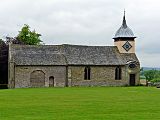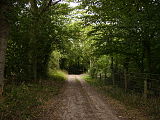- Croft Castle
-
Croft Castle [1] is a manor house and associated buildings near the village of Yarpole in Herefordshire, England some 7 km (4 mi) to the north-west of Leominster (grid reference SO449655).
Contents
11th century origin
A building has been on the site from the 11th century and it has from this time been the home of the Croft family and Croft Baronets.
The Croft family were closely linked to their neighbours the Mortimers of Wigmore and later Ludlow. The Battle of Mortimer's Cross took place on Croft lands nearby in 1461.
The present building originated as a castle in the 14th century and has been much altered since.
It was the home of a John Croft who married one of Owain Glyndŵr's daughters. In the 15th century the Croft family adopted the Welsh Wyvern crest, a wounded black dragon, seen as a subtle allusion to their Glyndwr heritage.
Croft Castle was restored after slighting in the Civil War.
Some members of this Croft family
- Sir Richard Croft (1429/30-1509), royal official for Kings Edward IV, Edward V, Richard III, and Henry VII
- Thomas Croft (c.1435-1488), shipowner and patron of Atlantic exploration
- Sir James Croft (c.1518-1590), lord deputy of Ireland and leading conspirator in Wyatt's Rebellion
- Herbert Croft (1603-1691), bishop of Hereford, chaplain to King Charles I and dean of the chapels Royal to Charles II
- William Croft (c.1678-1727), organist and composer
- Sir Herbert Croft (1751-1816), writer and lexicographer
- Sir Richard Croft (1762-1818), physician and man-midwife
- Sir Henry Page Croft (1881-1947), 1st Baron Croft, soldier and politician, Under-Secretary of State for War 1940-1945
- Sir James Herbert Croft (1907-1941), died on active service with No 1 Commando
- Andrew Croft (1906-1998), explorer and member of Special Operations Executive
Manor house
It now consists of a stone quadrangular manor house with a small castellated round tower at each corner [2] and a small square tower flanking the north side [3]. The castle is under the care of the National Trust and members of the Croft family still live within it.
The main building shares some similarities to Treago Castle, also in Herefordshire.[1]
The church
The castle and 13th century St. Michaels church adjacent [4], lie in 1500 acres (6 km²) of glorious Herefordshire countryside.
Inside the church is the fine altar tomb of Sir Richard Croft (1430-1509), high official to four monarchs and his wife born Eleanor Cornewall, before her remarriage the widow of Sir Hugh Mortimer of Kyre Wyard and Martley Worcestershire, killed in action at the Battle of Wakefield.
Parklands
The estate is noted for its veteran trees, particularly its avenues of Spanish Chestnut trees [5], oaks and beech trees and is one of the most important sites in North West Europe for veteran trees and dead wood invertebrates.
Owned and managed now by the National Trust it is open to the public from March to December and has many events, waymarked walks, including the Mortimer Trail, and talks.
The parkland also includes an Iron Age hillfort at Croft Ambrey [6].
External links
- Croft Castle and Parkland - Official site at National Trust
- Croft Castle on Herefordshire Council website
- Croft Castle on Castle UK website
- Croft Castle on Castlewales
- BBC Hereford & Worcester feature including 360 panoramic of Croft Castle
Coordinates: 52°17′05″N 2°48′33″W / 52.28486°N 2.80916°W
References
- ^ Pettifer, Adrian (2000). English Castles: A Guide by Counties. Boydell & Brewer. p. 102. ISBN 9780851157825. http://books.google.com/books?id=47iheRUGKIEC&pg=PA102. "Treago Castle is a late mediaeval walled quadrangle, resembling Croft Castle in overall effect..."
- Fry, Plantagenet Somerset, The David & Charles Book of Castles, David & Charles, 1980. ISBN 0-7153-7976-3
Categories:- Castles in Herefordshire
- National Trust properties in Herefordshire
- Grade I listed buildings in Herefordshire
- Leominster
- Historic house museums in Herefordshire
- England castle stubs
Wikimedia Foundation. 2010.




